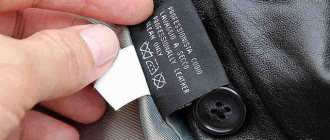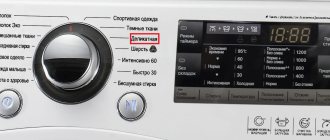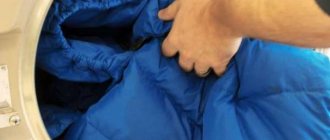It is known that men's suits made from high-quality fabrics are difficult to clean. As a rule, they are dry-cleaned and they pay a lot of money for it. But if contamination occurs frequently or is very small, spending money on washing is unprofitable. Therefore, many housewives are interested in whether it is possible to tidy up a suit on their own, either manually or using an automatic washing machine.
Of course, if we are talking about a cheap suit that you don’t mind ruining, you can risk cleaning it in the machine using ordinary detergents, but expensive tweed or woolen items, as well as ski clothes made from special fiber, it is better to wash them correctly so that they served as long as possible.
This should be done carefully, since any aggressive environment or excessive mechanical intervention can permanently ruin the beauty of the fabric.
How to wash a men's suit
Before you start cleaning your suit, you should carefully study the type of fabric, its properties, and read the tag. If we are talking about a classic suit, the jacket, as a rule, is only suitable for dry cleaning. It should not be washed in a machine, by hand or in any other way. This is due to the presence of many elements that must be rigid and keep their shape, for example, lapels, shoulders, side pockets, etc. But if it is not recommended to wash a jacket at home, then how to wash suit trousers?
First of all, determine whether it is possible to clean it yourself. To do this, they inspect the product, look for the tag, and if there is a crossed out basin on it, washing is prohibited. If you want to take a risk or wash your trousers, do it as follows:
- Check all pockets for various items.
- Apply a liquid product to the fabric and soak it in water for half an hour - this eliminates stains.
- Clean the surface of the trouser legs with a brush, especially in the most contaminated places (pockets, bottom of the product).
- Rinse, but do not wring out.
- Hang out straight to dry, then iron.
Some of these procedures can be replaced by washing in a machine, if you select a mode up to 40∘C, hand washing without spinning.
Washing in the shower
Manufacturers of some suits allow them to come into contact with water, but completely exclude washing. Another effective way to clean a product is “bathing” in the shower.
- The suit should be placed on a hanger with the legs and sleeves straightened.
- Pour water over the product.
- Apply a little washing gel or soap to a cotton rag or towel and wipe the problem areas of the product.
- Rinse the suit with cool water on the outside and then on the inside.
- If the detergent is not washed off the first time with running water, take a soft, clean brush, dip it in warm water and walk through the remaining detergent.
Article on the topic: Why is the LG washing machine leaking?
Now you can start drying. When everything has drained, hang the item in a dry room, unzip it and leave it for a while. When the suit is dry, fasten all the buttons, straighten the sleeves and legs, and give the correct shape to your item.
How to wash a suit jacket
First of all, pay attention to the material of the suit and its lining. Tweed, corduroy, wool - all this does not tolerate moisture, not to mention machine washing. They only need to be dry cleaned. To do this, hang the jacket on a hanger, take a high-quality brush that does not collect fibers, soak it lightly in water with a small amount of ammonia, and then thoroughly but gently clean the suit. Particular attention is paid to the elbows, cuffs, collars, and back - they are the most contaminated. After cleaning has been done, the suit remains almost dry. You can dry it completely with a hairdryer, and then use it.
Suit care
An elegant jacket gives a man charm and elegance. You can wear these clothes anywhere: to the office, to the theater, to a party and to an interview. But constant wear has a bad effect on the appearance of clothes. And a woman has a question: how to wash a jacket so as not to completely ruin it? Hang your suit jacket on hangers and carefully inspect it from all sides. If necessary, remove dust with a brush or even vacuum.
Shiny areas on the jacket can be cleaned with a brush and water with ammonia or vinegar added to it.
If you find stains of various etymologies, try to remove them using a stain remover. But first, look at the manufacturer's labels, which usually warn of possible risks. If the fabric is sensitive to rough touches (velvet, corduroy, wool), then use a soft rag instead of a brush.
How to wash a suit in the shower
A more original, but quite practical way is to wash a classic suit “in the shower”. This is quite simple to do, especially since the procedure will cause virtually no harm. “Shower” is indicated for:
- heavily soiled fabric;
- if dry cleaning does not help;
- when the lining fabric is heavily soiled.
But to ensure that the procedure is still safe, it is better to dry clean it first. And then proceed as follows:
- Carefully remove dust from the jacket by shaking it out.
- The suit is conveniently placed in the shower so that it is convenient to work with it.
- Water the suit with small streams of warm water, especially where it is dirty.
- Use a brush with liquid detergent to clean particularly dirty areas.
- Then remove the product with water and carefully dry the suit.
Under no circumstances should they do a hard wash with spinning or other mechanical stress. To make the operation better, the slightly damp suit is steamed with an iron.
Daily care and storage
To ensure that your suit lasts for many years, follow these tips:
- Don’t wear it out - let it rest in the closet, change it every day. Let your wardrobe have several pairs that you can alternate.
- Hang your jacket on a wide, voluminous hanger that follows the shape of your shoulders.
- Store seasonal suits in cases.
- Clean the fabric from dust with a special brush before hanging the clothes in the closet.
- Turn inside out and clean the cuffs of your trousers; dirt accumulates there most quickly.
- Hang your pants on a special trouser hanger.
- Do not put the item in the closet immediately after dry cleaning, let it air out.
How to properly wash a suit in a washing machine
This does not mean that all suits cannot be washed in automatic machines. Some tags do not prohibit this, so in such cases it is important to know how to properly care for such a product. First of all, you need to choose the right mode - this is a “delicate wash” at low temperature and low speed. Conditioner is added to the powder to make it easier to iron the jacket later, and the detergent itself is chosen liquid, since it is less aggressive (does not contain abrasives or other damaging elements). But this method should be used carefully and only for those suits where it is permissible, since one wash of, say, tweed fabric can destroy it forever.
How to iron correctly and video
To make a jacket look neat and tidy, it is important not only to be able to wash it at home, but also to iron it correctly. The best way to do this is to use a steamer. But not every housewife has such a device in her arsenal, so she has to cope with it with a regular iron.
Before ironing, you should leave the item on a hanger to allow water to drain. You need to straighten all the details: collar, pockets, sleeves, cuffs and lapels. Thus, the product will not lose its shape during the drying process.
To iron your jacket, it should be slightly damp. There is no need to dry completely. Iron the item through a clean cotton cloth. Some people take a piece of gauze for this. But this threatens the appearance of shiny areas. It is better to use denser material.
It is quite possible to freshen up a suit at home, even if it is made from delicate fabric. There is no need to go to the dry cleaner when you need to get your clothes in order. It is enough to know a few simple rules so as not to spoil the product.
Soaking method: washing principle, when to use
For fabrics that can withstand moisture and washing, another acceptable cleaning method is soaking. To do this, fill a basin with warm water, add a little liquid detergent and lay the suit down for half an hour to an hour. There is no need to squeeze it out, scrub anything, just let it sit. After this, remove the detergent and dry the product without squeezing. Then you need to iron the jacket with steaming through a gauze cloth.
It should still be remembered that wool, tweed, velvet and corduroy do not tolerate such cleaning - the dirt on them must be removed dry. Wool blend and satin can withstand hand washing, and cotton, polyester, linen can even be washed by an automatic washing machine.
Cleaning Methods
If any contact with water is contraindicated for the fabric, other cleaning methods are used to get rid of dirt. They can be dry or wet, but in any case they prevent complete soaking of the product.
Dry cleansing
The dry cleaning method is suitable for woolen items, as well as jackets and velvet jackets. To properly and safely clean a wool jacket from dirt, you need to proceed as follows:
- You need to hang it on hangers under bright light.
- Shiny areas of the product should be treated with a mixture of salt and ammonia (in a ratio of 4:1 tsp).
- Treat greasy stains with talcum powder, leave for a while and remove the residue with a brush.
- Dry cleaning products can be used to remove stains.
Tip: a popular method for getting rid of scuffs is to use raw potatoes, cut them off to treat the stains, and then wipe the treated areas with a damp cloth.
Wet cleansing
Wet cleaning of a product involves moistening the top layer of the product without deep penetration of water into the fibers of the fabric. This cleaning method is good for cleaning a jacket equipped with shoulder straps and chevrons.
Cleaning proceeds as follows:
- You need to prepare the solution by adding one teaspoon each of ammonia and ethyl alcohol to a glass of water.
- Place the jacket on a pre-prepared fabric.
- Treat with the solution using a soft brush, wetting the fabric generously.
- Leave for 10 minutes.
- Iron through cheesecloth.
- Hang on hangers in fresh air.
A good option for wet cleaning is steaming, which can be done using steam from hot water in the bathroom where the jacket is hung.
The process takes about 30 minutes, after which you need to move the item to fresh air.
A modern alternative to this method would be a household steamer, which will deeply clean the fabric fibers and straighten them.
Tip: When the product is completely dry, you should go over the pile with a dry brush.
How to wash ski suits
A ski suit is another item in the wardrobe of a man leading an active lifestyle that requires special washing conditions. And if a classic jacket and trousers made of expensive fabric cannot withstand moisture, as the appearance deteriorates, then sports fabric has special membrane properties, and exposure to excess moisture simply destroys these very properties.
Washing winter suits is an activity that is recommended to be done as rarely as possible. To do this, choose products with high-quality membranes that repel dirt.
But over time, they too become dirty. But unlike classic suits, these are not dry-cleaned, because they can completely destroy the membranes. You need to remove dirt yourself, manually.
Of course, you can also find a specialized dry cleaner that removes dirt from fabrics that have various impregnations. If you do everything yourself, you should, again, study all the inscriptions on the tag. So, if the tag shows a crossed out basin of water, washing this sports item is strictly prohibited - not only will the look be ruined, but the suit itself will be ruined, and you can simply throw it away. If you have a hand near the basin, you can wash it, but only by hand. The numbers 30, 40, etc. determine the maximum temperature for delicate washing, and a crossed out circle indicates the impossibility of dry cleaning.
Types of ski suits
There are many ski suits that differ in the type of fabric and, accordingly, methods of care. They are waterproof, windproof, wear-resistant, vapor permeable, elastic, durable, etc. The suits are made of polyamide, lycra, polyester, as well as fleece and membrane fabric as lining. Of course, all fabrics have advantages and disadvantages, and most importantly, they tolerate washing differently
How to wash a ski suit at home
It is best to clean such items by hand. For a long time now, household goods stores have offered detergents designed for cleaning things with membrane fabric. Of course, they are quite expensive, but they are the best means, which, moreover, will keep the membrane intact. They can be used to update your suit and prepare for the next season. If it is not possible to buy such a substance, you can simply purchase a product for delicate fabrics. But you should absolutely not buy bleaches or conditioners - they will destroy the suit.
Warm water is taken into a basin, the ski suit is placed there and washed by hand with detergent. After this, it is taken out and hung completely unfolded. It would be ideal to place a cloth under your wet suit for absorption. Like classic clothing, it should not be wrung out, twisted or otherwise subjected to mechanical processing. Also, heating elements should not be used to dry clothes. And after washing, the entire suit will need to be re-impregnated with a special water-repellent impregnation.
Is it possible to wash a ski suit in a washing machine?
It all depends on the materials of the suit. If it can withstand such a wash, you can select the delicate wash mode and wash, turning off the spin cycle. Down suits withstand this type of washing especially well. For them, the main thing is drying with a constant flow of warm air, and there are no special requirements for washing. Also, suits with some synthetic fillers are not particularly demanding to wash. For example, if you use Thinsulate filler, you can wash the product both in an automatic machine and by hand. But it is important to dry and clean it properly. As a rule, the manufacturer indicates its recommendations on the tag. It should be remembered that it is strictly forbidden to iron ski suits - this will completely destroy the membrane and make them unusable.
How to quickly remove stains on ski suits?
It is known that ski suits have a water-repellent coating. Therefore, if dirt gets on them, it is enough to add, say, more snow or moisture to it, wipe it all off (if we are talking about the first minutes of dirt getting in) - and it will be removed. If you have the opportunity to purchase products, stores sell cleaning agents for removing stains on membrane fabrics. They are used like this: apply the liquid to a sponge and rub it into the area of contamination, then rinse with water and wipe with a clean cloth. You should not use aggressive chemicals, as they destroy the membranes.
So, when purchasing men's suits, whether classic or sports, you should treat them very carefully, because, firstly, they use expensive fabrics that are not so easy to clean, and secondly, this is difficult to implement at home. But if you organize cleaning yourself, you should strictly follow the instructions, because by saving a little time or money, you can end up ruining the product, the cost of which is many times higher. In any case, it is better to trust the services of professionals who guarantee the safety of the product and its high-quality cleaning. You can only clean those items yourself that you are willing to lose or that are of little value.
General washing rules
There are a few rules to remember about whether you can wash your suit at home. They will help reduce the chances of unexpected troubles during cleansing procedures:
You can't rub your jacket
- Don't rub your jacket or pants too hard. Even if the suit is cleaned with a soft brush, there may be a risk of deformation of some part of the garment. The overall appearance of a solid tailcoat will not change for the better if the fabric begins to look shabby.
- For any type of washing (hand or using a washing machine), you must carefully monitor the glued parts. If a button or other important element of the suit accidentally comes off from the jacket, you need to carefully sew or glue it using special glue.
- All cleaning products used must first be tested on a small, inconspicuous fragment of the pants or jacket. Often the manufacturer will leave a fabric sample in the pocket. It is on this that it is worth experimenting with how the material behaves in contact with the chemical used.











